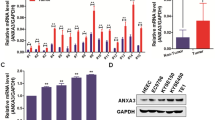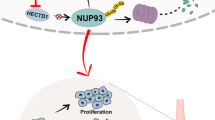Abstract
Background
HAX-1 is an anti-apoptotic factor and regulates the expression of DNA pol β. Interestingly, DNA polymerase pol β is overexpressed in esophageal squamous cell carcinoma (ESCC). However, the functional role of HAX-1 in ESCC remains unclear.
Aims
To investigate the role of HAX-1 in chemoresistance, invasion, and tumorigenicity of ESCC.
Methods
Lentivirus-mediated overexpression or knockdown of HAX-1 was employed to establish ESCC EC9706 cell lines that expressed HAX-1 at different levels. The biological behaviors of these engineered cells were characterized in vitro and in vivo using a xenograft nude mice model. In addition, HAX-1 and pol β expression in the tumor tissues was detected by RT-PCR and immunohistochemistry.
Results
HAX-1 overexpression promoted cell proliferation and resistance against cisplatin, increased cell invasion and suppressed apoptosis along with increased pol β expression. Conversely, HAX-1 knockdown inhibited the malignant phenotypes of EC9706 cells. The xenograft nude mice model demonstrated that HAX-1 overexpression or depletion led to increased or decreased tumor growth in vivo, respectively. Furthermore, a positive correlation of HAX-1 and pol β expression in the tumor tissues was observed.
Conclusions
HAX-1 promotes the proliferation, chemoresistance, invasion, and tumorigenicity of ESCC, and this is correlated with increased poly β expression. HAX-1 may represent a potential target to overcome the resistance and metastasis of ESCC.





Similar content being viewed by others
Change history
12 July 2019
The Editor-in-Chief has retracted this article [1] because Figure 3c appears to have been modified and reused as Figure 3d.
12 July 2019
The Editor-in-Chief has retracted this article [1] because Figure��3c appears to have been modified and reused as Figure��3d.
References
Pisani P, Parkin DM, Bray F, et al. Estimates of the worldwide mortality from 25 cancers in 1990. Int J Cancer. 1999;83:18–29.
Lehrbach DM, Nita ME, Cecconello I. Molecular aspects of esophageal squamous cell carcinoma carcinogenesis. Arq Gastroenterol. 2003;40:256–261.
Zheng X, Zhao Y, Wang X, et al. Decreased expression of CIAPIN1 is correlated with poor prognosis in patients with esophageal squamous cell carcinoma. Dig Dis Sci. 2010;55:3408–3414.
Ren HZ, Pan GQ, Wang JS, et al. Reduced stratifin expression can serve as an independent prognostic factor for poor survival in patients with esophageal squamous cell carcinoma. Dig Dis Sci. 2010;55:2552–2560.
Zhang H, Li M, Han Y, et al. Down-regulation of miR-27a might reverse multidrug resistance of esophageal squamous cell carcinoma. Dig Dis Sci. 2010;55:2545–2551.
Hu N, Wang C, Ng D, et al. Genomic characterization of esophageal squamous cell carcinoma from a high-risk population in China. Cancer Res. 2009;69:5908–5917.
Bass AJ, Watanabe H, Mermel CH, et al. SOX2 is an amplified lineage-survival oncogene in lung and esophageal squamous cell carcinomas. Nat Genet. 2009;41:1238–1242.
Sobol R, Horton J, Kühn R, et al. Requirement of mammalian DNA polymerase beta in base-excision repair. Nature. 1996;379:183–186.
Srivastava DK, Husain I, Arteaga CL, et al. DNA polymerase beta expression differences in selected human tumors and cell lines. Carcinogenesis. 1999;20:1049–1054.
Canitrot Y, Hoffmann JS, Calsou P, et al. Nucleotide excision repair DNA synthesis by excess DNA polymerase beta: a potential source of genetic instability in cancer cells. FASEB J. 2000;14:1765–1774.
Bergoglio V, Canitrot Y, Hogarth L, et al. Enhanced expression and activity of DNA polymerase beta in human ovarian tumor cells: impact on sensitivity towards antitumor agents. Oncogene. 2001;20:6181–6187.
Dong ZM, Zheng NG, Wu JL, et al. Difference in expression level and localization of DNA polymerase beta among human esophageal cancer focus, adjacent and corresponding normal tissues. Dis Esophagus. 2006;19:172–176.
Sarnowska E, Grzybowska EA, Sobczak K, et al. Hairpin structure within the 3′UTR of DNA polymerase beta mRNA acts as a post-transcriptional regulatory element and interacts with HAX-1. Nucleic Acids Res. 2007;35:5499–5510.
Suzuki Y, Demoliere C, Kitamura D, et al. HAX-1, a novel intracellular protein, localized on mitochondria, directly associates with HS1, a substrate of Src family tyrosine kinases. J Immunol. 1997;158:2736–2744.
Sharp TV, Wang HW, Koumi A, et al. K15 protein of Kaposi’s sarcoma-associated herpesvirus is latently expressed and binds to HAX-1, a protein with antiapoptotic function. J Virol. 2002;76:802–816.
Han Y, Chen YS, Liu Z, et al. Overexpression of HAX-1 protects cardiac myocytes from apoptosis through caspase-9 inhibition. Circ Res. 2006;99:415–423.
Cilenti L, Soundarapandian MM, Kyriazis GA, et al. Regulation of HAX-1 anti-apoptotic protein by Omi/HtrA2 protease during cell death. J Biol Chem. 2004;279:50295–50301.
Lee AY, Lee Y, Park YK, et al. HS 1-associated protein X-1 is cleaved by caspase-3 during apoptosis. Mol Cells. 2008;25:86–90.
Vafiadaki E, Arvanitis DA, Pagakis SN, et al. The anti-apoptotic protein HAX-1 interacts with SERCA2 and regulates its protein levels to promote cell survival. Mol Biol Cell. 2009;20:306–318.
Gallagher AR, Cedzich A, Gretz N, et al. The polycystic kidney disease protein PKD2 interacts with Hax-1, a protein associated with the actin cytoskeleton. Proc Natl Acad Sci USA. 2000;97:4017–4022.
Radhika V, Onesime D, Ha JH, et al. Galpha13 stimulates cell migration through cortactin-interacting protein Hax-1. J Biol Chem. 2004;279:49406–49413.
Ramsay AG, Keppler MD, Jazayeri M, et al. HS1-associated protein X-1 regulates carcinoma cell migration and invasion via clathrin-mediated endocytosis of integrin αvβ6. Cancer Res. 2007;67:5275–5284.
Yan S, Zhou C, Lou X, et al. PTTG overexpression promotes lymph node metastasis in human esophageal squamous cell carcinoma. Cancer Res. 2009;69:3283–3290.
Naldini L, Blomer U, Glay P, et al. In vivo gene delivery and stable transduction of nondividing cells by a lentiviral vector. Science. 1996;272:263–267.
Matsuda G, Nakajima K, Kawaguchi Y, et al. Epstein-Barr virus (EBV) nuclear antigen leader protein (EBNA-LP) forms complexes with a cellular anti-apoptosis protein Bcl-2 or its EBV counterpart BHRF1 through HS1-associated protein X-1. Microbiol Immunol. 2003;47:91–99.
Stewart SA, Dykxhoorn DM, Palliser D, et al. Lentivirus-delivered stable gene silencing by RNAi in primary cells. RNA. 2003;9:493–501.
Simmen T. Hax-1: a regulator of calcium signaling and apoptosis progression with multiple roles in human disease. Expert Opin Ther Targets. 2011;15:741–751.
Acknowledgments
We thank Dr. Zhi Huijun (NIH) for providing plasmids p∆8.2 and pVSV-G. We thank Biomedworld for providing a manuscript editing service.
Conflict of interests
The authors declare that they have no competing interests.
Author information
Authors and Affiliations
Corresponding author
Additional information
The Editor-in-Chief has retracted this article because Figure 3c appears to have been modified and reused as Figure 3d. An investigation by Zhengzhou University has confirmed that this figure was modified and reused. The data reported in this article are therefore unreliable. None of the authors has responded to any correspondence from the editor and the publisher about this retraction.
About this article
Cite this article
Sun, Sj., Feng, L., Zhao, Gq. et al. RETRACTED ARTICLE: HAX-1 Promotes the Chemoresistance, Invasion, and Tumorigenicity of Esophageal Squamous Carcinoma Cells. Dig Dis Sci 57, 1838–1846 (2012). https://doi.org/10.1007/s10620-012-2108-5
Received:
Accepted:
Published:
Issue Date:
DOI: https://doi.org/10.1007/s10620-012-2108-5




